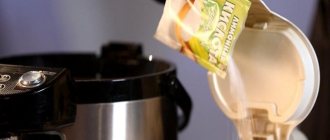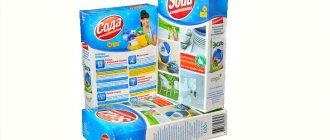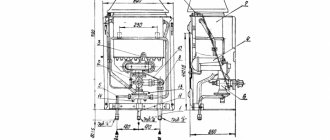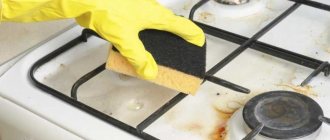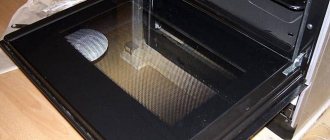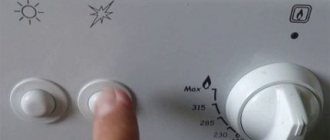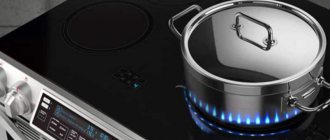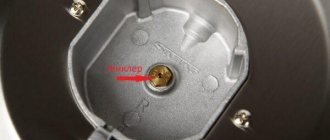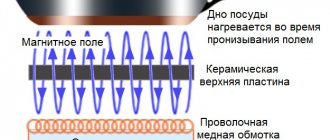Drops of fat, soot, food particles that settle on the grate bars during the cooking process - all this over time turns into a dense layer of soot, which is very difficult to get rid of.
It is possible to simplify the cleaning process as much as possible and achieve the desired result of shining gas stove grates only if the method and cleaning composition are correctly selected.
We will tell you in this article how to clean the grate of a gas stove from carbon deposits at home.
How to remove using folk remedies?
When cleaning gas stove grates, you should start with available means at hand (we save money and time spent on buying household chemicals).
Soda
Dry baking soda powder is a natural abrasive that perfectly cleans steel and cast iron rods.
Algorithm of actions:
- baking soda is diluted to a thick paste;
- the finished product is applied to the grill and left for thirty minutes;
- The treated surfaces are thoroughly rubbed with a brush or a hard sponge, and then washed off with warm water.
It is better to apply the baking soda paste to the slightly moistened surface of the rods.
Mustard
Fresh mustard or dry mustard powder is a gentle means for cleaning grates from carbon deposits (does not leave scratches or abrasions).
Algorithm of actions:
- Wipe the grill thoroughly with a damp cloth.
- Dry mustard is diluted with water to form a thick paste.
- The prepared mixture is applied to each rod and left for at least three hours.
- Treated surfaces are thoroughly wiped with a rag, hard sponge or brush.
There is no need to dilute fresh mustard with water before applying it to the grill.
Laundry soap and office glue
A product whose effectiveness has been tested by time is a mixture of soap and office glue.
The alkalis contained in the glue enhance the cleaning properties of soap, helping to dissolve hardened layers of fat and soot.
Algorithm of actions:
ten liters of water are poured into a bowl or large saucepan, in which 150 ml of office glue and a bar of laundry soap grated on a coarse grater are stirred;- place the prepared pan on the fire and bring its contents to a boil;
- I lower the dirty grates into boiling water and continue the boiling process for another hour;
- after sixty minutes, remove the pan from the heat, remove the grates, clean each rod with a stiff sponge or brush;
- the already cleaned surface is washed again under warm running water.
During the boiling process, make sure that the grate is completely immersed in water. The boiled liquid is added as needed.
How to clean a gas grill at home: what products come to the aid of housewives
In addition to household chemicals, which you would like to use least of all, compounds that have been used for a long time are considered accessible. Moreover, homemade products clean surfaces no worse than professional chemicals. Let's look at proven methods for removing deposits on gas grates, implemented at home.
We use household appliances and chemicals
After processing in the dishwasher, the grease will be removed from the grill, all you have to do is dry the device and put it back in place
To effectively remove dirt and grease on steel and cast iron grates, you can use a dishwasher. This option is acceptable if this part of the stove is disassembled and fits sufficiently into the device. To do this, you need to add a special cleaning tablet and run the dishwashing mode for the longest procedure. If dirt still remains, try additionally rinsing the grill with a hard sponge and dishwashing gel.
A steam generator, as a fat softener, will help in cleaning the gas stove grate from carbon deposits.
Using a steam generator, you can wash gas stove burners and other removable parts
If you have such an assistant in your home, you can safely use it. To do this, remove the stand from the stove and place it in a metal container or bath. Apply steam on all sides, and the processing temperature should be maximum. Allow the grill to cool and remove all deposits with a soft, damp cloth. Then rinse and dry the part.
Universal household cleaners
Don’t neglect the cleanliness of your gas assistant, the more dirt there is on it, the more difficult it is to remove it
Most household chemical compositions are intended for washing gas grilles of any structure: be it cast iron, enameled or steel parts. Effective and harmless cleaning products are those that do not contain active chlorine. In this table we consider a list of good and affordable household chemicals.
| Product name | Description | Average price, as of May 2021, rub. |
| Cream "Sif" |
| 100 |
| Foam "Shine" |
| 120 |
| Cream "Bright" |
| 200 |
| Gel "Amway" |
| 350 |
| Spray "Silit" |
| 250 |
When purchasing a cleaning product for gas stove grates, you should not rely on advertising; it is advisable to first read the instructions for the composition (this can be done in a store).
Ammonia will help clean the gas stove grate from all contaminants.
Do not wash gas grilles with ammonia without using respirators, otherwise there is a high risk of poisoning by the vapors of the product.
Surely every first aid kit has ammonia. This product has a very specific, pungent odor, so when in contact with it, follow safety precautions. To begin cleaning, remove the metal stand from the tile and take it outside, away from the house. Place in a large trash bag and generously rub all parts with ammonia or simply pour a few vials of product into cellophane. Leave the grill for 3-4 hours, then rinse off any residue with warm water and dry the grill.
How to clean carbon deposits from a gas grill with soda and mustard: a caustic but gentle compound
It is better to wash pot stands from gas stoves in warm water with any product. This way all compounds react better.
Mustard has long been considered a useful remedy in everyday life. It turns out that the pulp from it adds shine to all surfaces in the house, and also eliminates unpleasant odors. Before using dry mustard, it is better to soak the grates in a solution of soda and water in a 1:1 ratio and leave for two hours. Then apply mustard powder using a sponge, transfer to a container of suitable size, and leave for a few more hours. After the time has passed, rinse the part well and dry.
Using household chemicals
Special chemical compounds designed to remove stubborn fat deposits, soot and soot will quickly return the gas stove grate to its original appearance. There is a wide range of household chemicals on the shelves of hardware stores.
Gels carefully remove grease, do not leave scratches , and are ideal for any materials. When choosing a cleaning spray, you must carefully study the composition (high concentrations of acids and alkalis are dangerous for cast iron and enameled surfaces). Otherwise, the spray is very convenient to use; it helps to save product consumption by spraying it onto the surface through a special spray bottle.
Abrasive powders are attractive at a fairly low cost (an order of magnitude lower than the price of a gel or spray). But abrasive is not suitable for glossy surfaces. In other cases, before application, it is recommended to dilute the powder with water to form a thick paste.
TOP - the most effective means of removing carbon deposits from a gas stove grate:
Top House Grease Cleaner
Will dissolve without residue:
- congealed fat,
- soot,
- burnt food.
Polishing microgranules in the spray will return the original gloss to the gas stove grate. After using the spray, a protective film is formed on the surface, making subsequent cleaning easier.
A convenient spray bottle helps to save cleaning product consumption. The average cost is 400 rubles. (500 ml bottle). Read reviews here.
Mr. Chister
In just three minutes it will remove stubborn grease, soot and carbon deposits from the grate of a gas stove . It is enough to spray the composition onto the contaminated surface, wait a little and rinse with warm water. The average cost is 220 rubles. (500 ml bottle). Read reviews here, on this and this review site.
Grease remover spray Sanita
The product from a Russian manufacturer is suitable for removing particularly difficult contaminants (grease, soot, burnt food). Recommended for treating gas stove grates and other kitchen surfaces made of:
- become,
- cast iron,
- enamel,
- stainless steel
Simply spray the product onto the stain, wait one minute, and rinse with warm water. The average cost is 170 rubles. (500 ml bottle). Read reviews here, here and here.
You can work with household chemicals only after thoroughly studying the manufacturer’s instructions, in a well-ventilated area, using protective rubber gloves.
We use household chemicals correctly
Few people know how to properly use household chemicals. However, it can not only damage the surface, but also cause harm to health. To prevent this from happening, read the table.
| Name | Application | Precautionary measures |
| CIF Active lemon | Cleans any grate. Apply with a sponge to the surface, then rinse off with plenty of water. | Make sure that splashes do not get on the linoleum. Wear gloves, protect your eyes and respiratory organs. |
| Sanita gel | Apply the product, wait 15 minutes and wipe with a sponge. | It will not help against old carbon deposits. |
| Schumann | Apply the liquid, immediately wipe with a cloth and rinse with water. | Start from an inconspicuous place. Do not use for cleaning aluminum and Teflon surfaces, use with caution on enamel surfaces. |
| Cillit Bang “Anti-fat” | Apply, wait 10 minutes, wipe with a brush or hard sponge. | Do not use on cast iron or enamel surfaces. |
| Amway Oven Cleaner | Pour some of the product into the dispenser cap and apply carefully with a brush. Wait 30 minutes and wash off. | Does not cope with dried deposits that have lasted many months. Prohibited for use on aluminum, painted and chrome surfaces. |
Household chemicals in this category include phosphoric or other acid. Always work carefully, protect animals and children from negative impact.
Heat treatment
Roasting metal with an open fire (calcination or heat treatment) is an excellent way to quickly clean the steel grates of a gas stove from dense layers of carbon deposits. This type of cleaning cannot be used for cast iron or enamel rods.
The steps are simple: using the open flame of a blowtorch, the burners of the gas stove burn the rods of the gas grate. Under the influence of high temperatures, the fat breaks down into tiny particles and all that remains is to wipe the surface with a clean damp cloth.
Types of gratings
The gas stove is equipped with grates made from three types of material.
- Cast iron. It is strong and durable, but the grate of a gas stove made of this material cannot be cleaned using any means. Strong components remove dirt, but can lead to deformation of the product.
- Enameled metal. It is easy to remove soot from such a grate, but there are problems with removing burnt organic matter.
- Steel mesh. Such models are used most often and withstand mechanical stress well.
Wire brush
Hard cleaning with metal brushes is suitable when the grate on the gas stove is not removable.
Algorithm of actions:
- the rods are moistened with water;
- using a stiff metal brush, scrape off dirt with active circular movements;
- The cleaned surface is wiped with a clean damp cloth.
You can simplify the mechanical cleaning process if you use a drill with a special brush attachment.
Cleaning features depending on the material
The first thing you need to do when starting to clean the gas stove grate is to find out what material it is made of. This knowledge directly influences the choice of cleaning method and type of detergent.
Cast iron
Cast iron rods are very difficult to maintain . Cast iron scratches very easily. Therefore, such products cannot be scraped with a knife or other sharp objects, or be beaten off the surface with a hammer. Cast iron does not withstand the aggressive effects of acidic compounds.
The best option for cast iron grates is cleaning with a steam generator or heat treatment (cast iron tolerates heat very well).
Stainless steel
Stainless steel gratings are resistant to chemicals and abrasives. Stainless steel is easy to clean from carbon deposits using a wire brush, sand or soda. It is enough to slightly moisten the metal with water, and then thoroughly rub the stains.
Enamel
Lightweight enamel-coated gratings are sensitive to rough mechanical and aggressive chemical influences.
The method of soaking in a soap solution will help remove carbon deposits from such surfaces . Dissolve 100 ml of liquid dishwashing detergent in 10 liters of water.
The frying pan is soaked in the resulting mixture for at least six hours, after which the dirt can be easily removed with a soft brush or sponge.
How to wash depending on the type
Few of us can say right away what material the grate on his kitchen stove is made of: enameled or steel. There is nothing wrong with this, the main thing is that everyone will be able to distinguish cast iron, because it has some restrictions in cleaning. So:
- Steel gratings can be washed with caustic substances and containing abrasives.
- Enameled metal ones are smooth, lightweight, resistant to water and medium-hard brushes. You should avoid using strong substances, for example, car engine cleaning fluid.
- Cast iron is rough, porous, despite its strength and durability, it is not recommended to subject it to prolonged soaking, even despite heavy carbon deposits. It is believed that the best way to clean them is calcination. You definitely shouldn’t do this at home, even if it’s heavily soiled. But if it is possible to do this at the dacha, then you can calcine it with fire until pieces of soot fall off.
How to prevent plaque from appearing?
To ensure that your gas stove grate always shines clean, you must follow these rules:
- Cleaning - after each cooking . There's nothing easier than wiping down the grill with a damp cloth at the end of the day. Spending two minutes on regular cleaning will save two hours on removing stubborn grease and grime.
- A chip-free surface means less dirt . The fewer scratches, abrasions and chips there are on the gas grill, the easier it is to keep it clean.
A life hack from experienced housewives: coarse salt, sprinkled on greasy stains immediately after they appear, prevents grease particles from attaching to the grate of the gas stove.
Adviсe
A few tips from experienced housewives will make the difficult process of cleaning carbon deposits from gas grills easier:
- Fresh traces of soot can be easily removed with lemon juice. It is enough to wipe the rods with a slice of fresh citrus and there will be no trace of greasy stains left.
- The soaking time in the soap solution should not exceed six hours. Prolonged contact with water destroys the protective layer of metal rods.
- Liquid for washing car engines is an effective tool in the fight against carbon deposits on cast iron grates.
Life hack: using cookware with high sides helps keep the grates and work surface of the gas stove clean.
Methods and means for cleaning various surfaces from carbon deposits are presented in this section.
